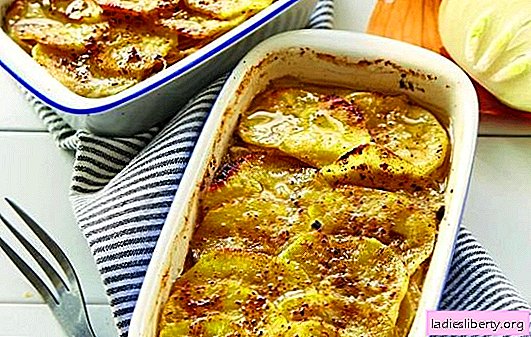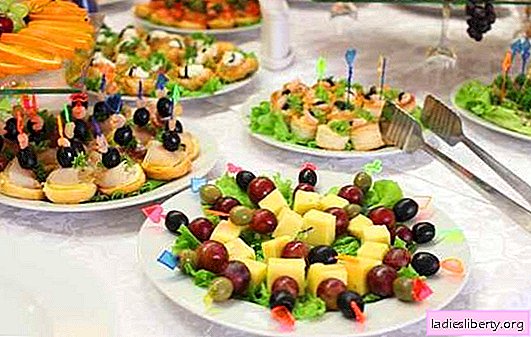
Pies is a topic that always interests housewives. Although everything has already been invented and told, but still I want to make sure once again that everything is done correctly, or to learn something new for myself about pies with cabbage, in great detail, in step-by-step recipes, to achieve perfection in the preparation of the dough, so that everyone gasped, as they say.
It also happens that you already know everything, but some insignificant detail that was missed earlier, just changes the whole thing. Let's try not to miss it this time, so that the pastry for pies turned out perfect. As for the filling, it is always the most delicious part of the pie, and the only thing everyone wants is to have more.
Step-by-step recipes for cabbage pies - basic technological principles
For the preparation of pies, yeast or unleavened dough is traditionally chosen. Each housewife has a secret of its preparation, which she inherited, but each dough recipe for pies and pies with cabbage has a basis. Here, special attention must be paid to it so that then any step-by-step recipe for pies with cabbage does not cause any questions and does not create unexpectedly unpleasant results.
Knowledge of biochemistry helps a lot in making the right recipe. Using this science, you can take any recipe you like, adjust the amount of ingredients in accordance with your taste, the availability of products and their quality characteristics. The dough will always be the best if a scientific approach is involved in its preparation.
Test biochemistry
Any dough consists of dry and liquid ingredients. Dry components include those that contain the least amount of moisture: flour, starch, cereals, cocoa, baking soda, milk powder, albumin (egg white). Of course, the listed ingredients also contain water, which affects the quality of the finished dough.
At home, an accurate analysis of these products is difficult, and no one will do it. Therefore, just remember that dry components give an error in the preparation of the dough, at least up to 25%, since absolutely dry products do not exist. The second group of products is the wet components of the dough: water, milk and all dairy products, including butter; vegetable oil, sugar, alcohol (pressed yeast), eggs. They contain more than 80% (water - 100%) moisture and make up the liquid base of the dough.
That is, if a step-by-step recipe for pies with cabbage, for example, indicates that the dough includes water and flour, and nothing else, then you need to balance these ingredients so that their weight is exactly the same. Knowing that the moisture content of wheat flour, in accordance with the standard, is 14%, you need to knead the dough based on: 1 kg of flour in 860 ml of water. Equal content of dry and solid substances in the dough is the key to success. After baking, the water added to the dough will partially evaporate. During evaporation, it is known to pass into a gaseous state, which contributes to the formation of pores in the dough. Everything else - fats, egg whites, yeast and sugar, dairy products - are necessary to enhance this effect. By adding liquid components, respectively, reduce the amount of water or increase the amount of flour.
For principles of making a good dough for pies with cabbage, read also step-by-step recipes and useful tips.
Pies with cabbage - step by step recipes for yeast dough
Ingredients:
Milk (3.2%) 500 ml
Pressed yeast 75 g; dry - 25 g;
Sugar 60 g
Flour (premium) 850 g
2 table eggs
Salt 10 g
Margarine 80 g
Test yield: +/- 1.5 kg
For the filling: stewed cabbage with vegetables and rice - 750 g
Cooking Technology:
Yeast dough is prepared in a double and steamless manner; There is also a cold method for preparing puff yeast dough, which differs fundamentally from the first two options.
Before you begin the study of a step-by-step recipe for cabbage pies, note that the presence of yeast in the dough gives splendor, and they are necessary, but the quality of baking depends on their proper use.
Excess yeast and insufficient amount of time allocated for proofing the dough leads to the fact that finished products from yeast dough have a characteristic and unpleasant odor of non-fermented yeast, quickly deteriorate (they are affected by mold, other microorganisms). It is such baking that is harmful to a slim figure. But to miss the moment when the yeast has already processed carbohydrates, and the dough has risen and became airy, that is, filled with bubbles of carbon dioxide released by the yeast, it is also impossible.
In order for the dough to remain splendid for a long time, to keep the released carbon dioxide, it must be ductile. Therefore, when mixing, it is important to observe the correct ratio of dry and liquid components, which was mentioned above, and also not to rush at this stage. In order for the liquid and flour to combine with each other, forming strong "threads" of water and gluten, the dough must be thoroughly mixed, give it time to "rest".
Unpaired way
All products for the test must be warmed to room temperature.
Heat the milk to a temperature of 20-25 ° C, so that the yeast is comfortable to work. Add sugar and a third of the flour: microorganisms need the energy that sugar provides and nutrition to work. The resulting liquid mass should have an average consistency, like a dough for cooking fritters. When warm, the surface of the batter will be covered with bubbles after 15 minutes, but try not to rush - let the yeast process sugar and the carbohydrates contained in the flour will release more gas.
Melt the margarine. Fat molecules are larger than water molecules, so adding it to the dough increases the chances of getting a magnificent dough. In addition, fat gives the dough plasticity, retains moisture and air during baking, which further increases the rise of pies in the oven. But pour the melted fat into the batter slightly chilled so that it does not “burn” the yeast, because their work is not finished yet.
Beat eggs in lush foam. When whipped, they will also saturate the dough with oxygen. Add egg foam to the batter. Mix thoroughly until a homogeneous emulsion is formed.
Sift the flour, even if it was already sieved yesterday. More oxygen in the dough - better pies. Knead the dough, gradually sifting flour into it. If you use a combine for kneading, then check the plasticity of the dough by pulling it with your hands: the dough should not break when stretched, it should not stick to your hands. When mixing manually, focus on the "grandmother's secrets": try to knead with movements from the bottom up, immediately sweeping in the center; when manually kneading, raise the dough and stretch it slightly to saturate it more with oxygen.
Cover the dough, put closer to the heat. When it doubles, start sculpting pies.
For a lean method, try using compressed yeast, since it is less resistant to temperature when baking, and the yeast must die in the oven so that they do not continue to work in the body, falling into the stomach with pies.
Dough dough
This method differs from the first by the kneading technology, and the composition of the ingredients remains the same.
Heat milk or water - 80% of the volume. Dissolve the yeast in the remaining liquid.
Add half the sifted flour, mix the dough until a homogeneous consistency. Sprinkle the surface with flour, cover with a towel and send for proofing, for two or three hours.
Opara must ferment well. First, it will increase in volume, and when it begins to settle (do not miss this moment!), Add beaten eggs, the remaining liquid, flour. At the end of the batch, pour in the warm melted fat (margarine, vegetable or butter).
Knead the dough to a plastic state. Ready-made air dough "puffs" when kneading.
Transfer to the heat again for proofing, covering the dough with a towel or film. During proofing, the dough must be kneaded at least two times. When pressed, the finished dough is leveled, does not stick to the hands.
Dough dough products are more useful since all fermentation processes in it are completed before baking. You can add more muffin to the dough.
Yeast Puff Pastry - The Third Way
This method requires chilled products, yeast dough is cooked in a cool room so that the fat does not have time to heat up and melt during the lamination process. As a rule, muffin is not added to the puff yeast dough. Therefore, exclude eggs and sugar from the list of ingredients, replace milk with water, and the amount of margarine should be increased, corresponding to the mass of excluded products.
Ingredients:
Water 500 ml
Pressed Yeast 75 g
Salt 10 g
Margarine (or other fat) 250 g
Flour 850 g (including 250 - for rolling)
Cooking:
Dissolve the yeast and salt in a small amount of water (10-15% of the total volume) at room temperature, pour the liquid into the rest of the water, cooled to 10-15 ° C.
Sift the flour, separate 250 g for rolling the dough and its lamination, knead the steep dough from the rest. Put in the refrigerator, covering with a film.
Chopped frozen margarine or butter with a knife (or grate), combining with the remaining flour.
The prepared amount of crumbs should be enough for at least 16 layers of dough, so distribute it in advance to sprinkle the rolled dough evenly.
Grease the surface of the table and rolling pin. Roll the dough very thinly into a square or rectangle. Sprinkle a thin layer of cooked fatty crumb, wash it with your palm so that it does not crumble. Fold the layer with an envelope, roll it to the previous size, and again sprinkle with oil crumbs.
Roll the finished dough, put it in the cold so that it stays cool until the proofing of the finished semi-finished products.
Prepare the filling, ventilate the room so that the puff pastry dough does not begin to rise when molding the pies, ahead of time. Preheat the oven only after the semi-finished products are fashioned.
Pies made from puff yeast dough rise very quickly and well in an oven filled with steam.
Cooking the stuffing for pies with cabbage - a step by step recipe
The ratio of filling and pastry in pies is 1: 1. If you prefer juicy cabbage, then increase the amount of dough by 10%: to prevent juice from flowing out onto a baking sheet, you need to wrap the filling in the dough very carefully. To prevent the filling from flowing out of the dough, add mashed potatoes, pea porridge, boiled rice, mushrooms or boiled fish to the stew.
Stewed cabbage with tomato
Ingredients:
Fresh cabbage 0.5 kg
Carrot 120 g
Onion 200 g
Tomato Paste 75 g
Spices to taste
Oil 100 g
Cooking:
Chopped peeled vegetables finely.
Heat oil, fry onion and butter until soft.
Put cabbage in a pan or stew-pan, simmer until tender. The filling volume should decrease by 25-30%.
Add tomato paste diluted with a little water with spices. Stew the vegetables for another five minutes. Chill.
Stuffing for pies with cabbage is ready. To thicken it, add the components listed above. Consistency choose at will.
How to bake pies with cabbage?
Having chosen one of the ways to prepare the dough for yourself, choose the method of baking. Cabbage pies can be fried in a pan, deep-fried or baked in the oven.
To fry in a pan, give the patties a flat oval shape. Preheat the pan by adding a little vegetable oil. Lay out the semi-finished products at a distance of 1.5 cm, as they will increase in volume when roasting. Withstand moderate temperatures. Turning the pies over, after one side of the pies is browned, cover the pan with a lid for 2-3 minutes - this will add splendor to them, and the dough will not turn out to be baked by accident.
For deep-frying, use refined oil. Bring it to a boil, turn down the heat, and carefully lower the pies. For deep-frying, the shape of the patties can be either flat or convex, depending on the depth of the dishes in which they are fried, but semi-finished products should be completely immersed in boiling oil.
For oven pies, preheat the oven to 180 ° C. Place the pies on a greased baking sheet. Prepare a mixture to lubricate the surface of the pies: beat the egg by adding 50 g of melted butter. Before you put the baking sheet in the oven, apply the egg-oil mixture with a brush on the surface of the pies so that they have a rosy appearance.
Step-by-step recipe for pies with cabbage - useful tips
For the preparation of fresh (yeast-free) dough, fermented milk products are ideal in combination with baking powder or baking soda. Add the powder to the flour, not the liquid, so that the reaction occurs in the dough. If you add soda to kefir, whey or yogurt, then the gas will evaporate in vain, without giving splendor to the dough. In a yeast-free dough, it is good to add a little alcohol - 50 ml per 0.5 liter of liquid.
After kneading, unleavened dough, like yeast dough, needs time to start fermentation. Therefore, it is good to cook this type of dough for pies with cabbage in advance, for example, in the evening, and leave at room temperature. In the morning, you need to add a little flour to it, knead again and start sculpting the pies.











